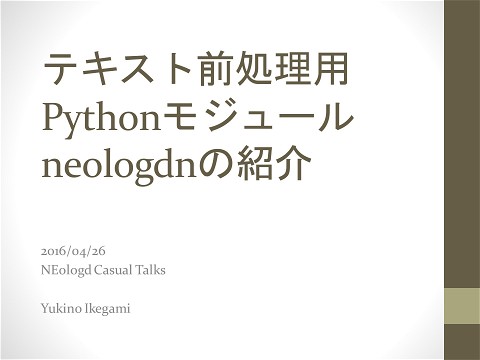Clause Anaphora Resolution for Japanese Demonstrative Determiner based on Semantic Similarity between Different Parts-of-Speech
>100 Views
June 15, 15
スライド概要
My presentation about anaphora resolution at SMC 2013.
池上有希乃です・・・†
関連スライド
各ページのテキスト
Clause Anaphora Resolution for Japanese Demonstrative Determiner based on Semantic Similarity between Different Parts-of-Speech Yukino Ikegami Ernesto Damiani Akihiro Urano Setsuo Tsuruta At SMC 2013
Background • Informal/colloquial style texts often contain anaphoric expressions (e.g.) I like such words. • What is “such” in “such words” means? ➢ The answer depends on context ➢ There is an ambiguity ➢ Anaphora resolution: Automatically resolving anaphoric relation 2013/10/15 SMC 2013 2
Related works • Conventional anaphora resolutions mainly deal with nominal anaphoric • Heuristic rule & ontology based anaphora resolution [Murata 2000] – Resolves {nominal, adjective, adverb} anaphoric – It assumes that antecedent is noun phrase or previous sentence 2013/10/15 SMC 2013 3
Problems on Anaphora Resolution • Conventional anaphora resolutions are not enough to resolve following case: ◼Demonstrative determiner refers a clause – We call “clause anaphoric” – E.g. He inquire xxx. I think such question ---. – Part-of-speech (POS) of anaphor and POS of antecedent are often different in this case 2013/10/15 SMC 2013 4
Our proposed method • Semantic similarity based anaphora resolution for Japanese demonstrative determiner • Consider synonymous relationship crossing parts-of-speech – E.g. Deal with the verb “talk” as synonym of the noun “tale” 2013/10/15 SMC 2013 5
Procedure of our method • Preprocessing phase 1. Dependency Parsing 2. Semantic Role Labeling & Giving word semantics 3. Conceptual Dependency structure parsing • Anaphora Resolution phase 1. Find demonstrative pronouns 2. Extend semantics of anaphor words using Semantically relationship table 3. Choose the most similar candidate 2013/10/15 SMC 2013 6
Preprocessing 1. Syntactic dependency structure parsing – CaboCha [Kudo et al. 2002] 2. Semantic role labeling & giving word semantics – ASA [Takeuchi et al. 2010] 3. Conceptual Dependency Structure Parsing – Conceptual dependency [Schank 1972] 2013/10/15 SMC 2013 7
Anaphora resolution (1) Find Demonstrative Determiner • Finds demonstrative determiner by morphological analysis (e.g.) I wonder what that story told by the managing director was. • If not found, terminates anaphora resolution 2013/10/15 SMC 2013 8
Anaphora resolution (2) Extend word semantics 1. Extract similar words from semantically relationship table 言う (say) - 発声 (utterance) Semantic relation Table 言う (say) – 話 (story) 話 (story) - 発言(statement) - 言葉 (word) - 発声 (utterance) Add 1. Add semantics of similar words to semantics of the anaphor phrase 2013/10/15 SMC 2013 9
Anaphora resolution (3) Choose the most similar candidate • Measure semantic similarity between anaphor phrase and each candidates • Ontology path similarity Lm Ln + L1 L2 sim ( w1, w2 ) = Lm + Ln • The most similar word is chosen as antecedent 2013/10/15 SMC 2013 10
Evaluation Experiment Counseling dialogue Accuracy 100% Twitter 63.04% Novel 62.5% Dataset: Contain the phrase あの話 (“that conversation”) Accuracy: Agreement rate between human and our method 2013/10/15 SMC 2013 11
Major causes of failures in evaluation experiments • Lack of synonymous relationship – Need automatically acquiring synonymous relationship • Specific expression in written language – E.g. Use quotation marks instead of verbs – Need cooperating with rule based method • Cataphoric/exophoric expression – Need detecting implied reference 2013/10/15 SMC 2013 12
Conclusion • Semantic similarity based anaphora resolution for Japanese demonstrative determiners – Consider synonymous relationship crossing Parts-of-speech (POS) – Can resolve clause anaphoric, not only nominal anaphoric 2013/10/15 SMC 2013 13
References • [Murata 2000] M. Murata, “ Anaphora resolution in japanese sentences using surface expressions and examples, ” arXiv:preprint, cs/0009011, 2000. • [Kudo et al. 2002] T.Kudo and Y.Matsumoto. “Japanese dependency analysis using cascaded chunking”, in Proc. of the 6th Conference on Natural Language Learning 2002, pp. 63-69, 2002. • [Takeuchi et al. 2010] K. Takeuchi, S. Tsuchiyama, M. Moriya and Y. Moriyasu, “ Construction of argument structure analyzer toward searching same situations and actions ” (in Japanese), IEICE technical report Natural language understanding and models of communication, vol. 109, No.390, pp.1-6, 2010. • [Schank, 1972] R. Schank. “ Conceptual dependency: a theory of natural language understanding, ” Cognitive Psychology, Vol.3, No.4, 1972. 2013/10/15 SMC 2013 14





